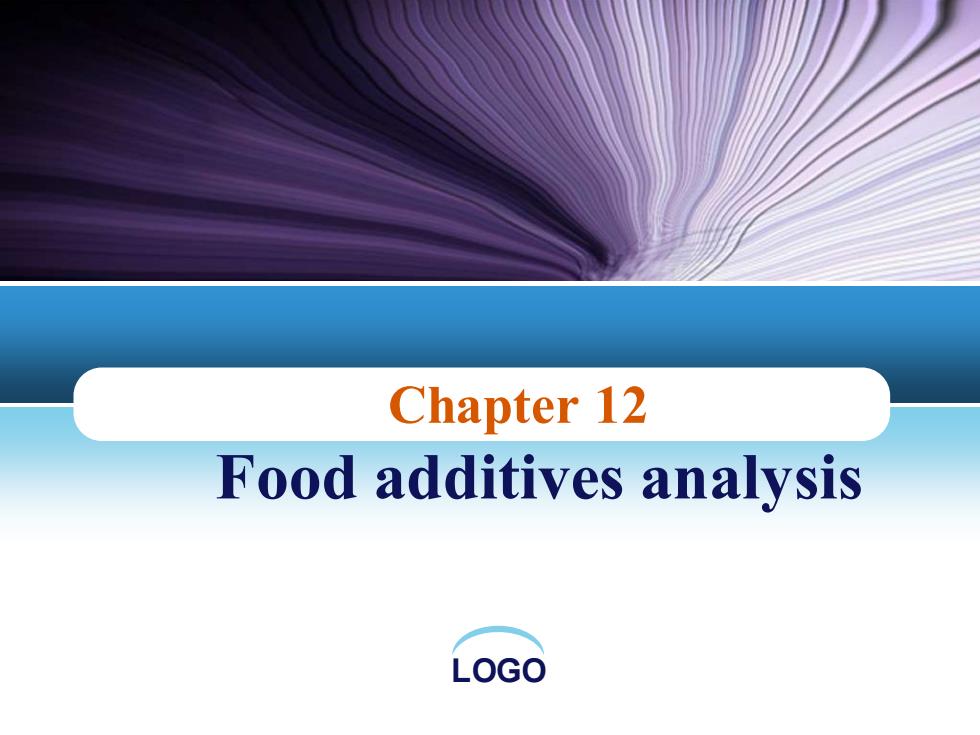
Chapter 12 Food additives analysis LOGO
LOGO Chapter 12 Food additives analysis
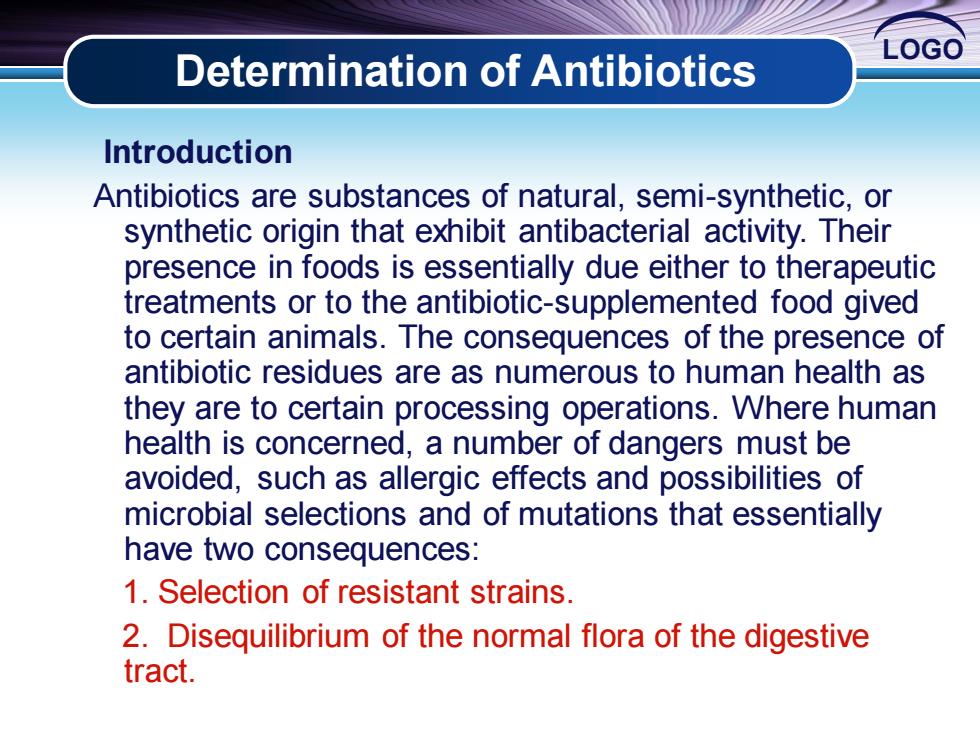
LOGO Determination of Antibiotics Introduction Antibiotics are substances of natural,semi-synthetic,or synthetic origin that exhibit antibacterial activity.Their presence in foods is essentially due either to therapeutic treatments or to the antibiotic-supplemented food gived to certain animals.The consequences of the presence of antibiotic residues are as numerous to human health as they are to certain processing operations.Where human health is concerned,a number of dangers must be avoided,such as allergic effects and possibilities of microbial selections and of mutations that essentially have two consequences: 1.Selection of resistant strains. 2.Disequilibrium of the normal flora of the digestive tract
LOGO Introduction Antibiotics are substances of natural, semi-synthetic, or synthetic origin that exhibit antibacterial activity. Their presence in foods is essentially due either to therapeutic treatments or to the antibiotic-supplemented food gived to certain animals. The consequences of the presence of antibiotic residues are as numerous to human health as they are to certain processing operations. Where human health is concerned, a number of dangers must be avoided, such as allergic effects and possibilities of microbial selections and of mutations that essentially have two consequences: 1. Selection of resistant strains. 2. Disequilibrium of the normal flora of the digestive tract. Determination of Antibiotics
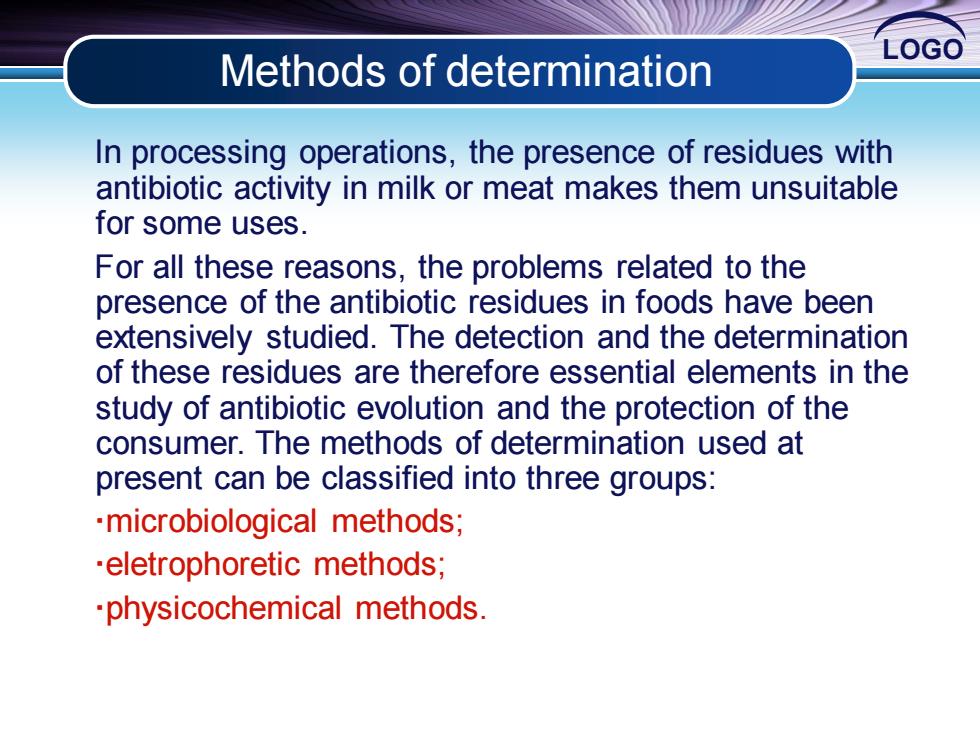
LOGO Methods of determination In processing operations,the presence of residues with antibiotic activity in milk or meat makes them unsuitable for some uses. For all these reasons,the problems related to the presence of the antibiotic residues in foods have been extensively studied.The detection and the determination of these residues are therefore essential elements in the study of antibiotic evolution and the protection of the consumer.The methods of determination used at present can be classified into three groups: .microbiological methods; eletrophoretic methods; physicochemical methods
LOGO Methods of determination In processing operations, the presence of residues with antibiotic activity in milk or meat makes them unsuitable for some uses. For all these reasons, the problems related to the presence of the antibiotic residues in foods have been extensively studied. The detection and the determination of these residues are therefore essential elements in the study of antibiotic evolution and the protection of the consumer. The methods of determination used at present can be classified into three groups: ·microbiological methods; ·eletrophoretic methods; ·physicochemical methods
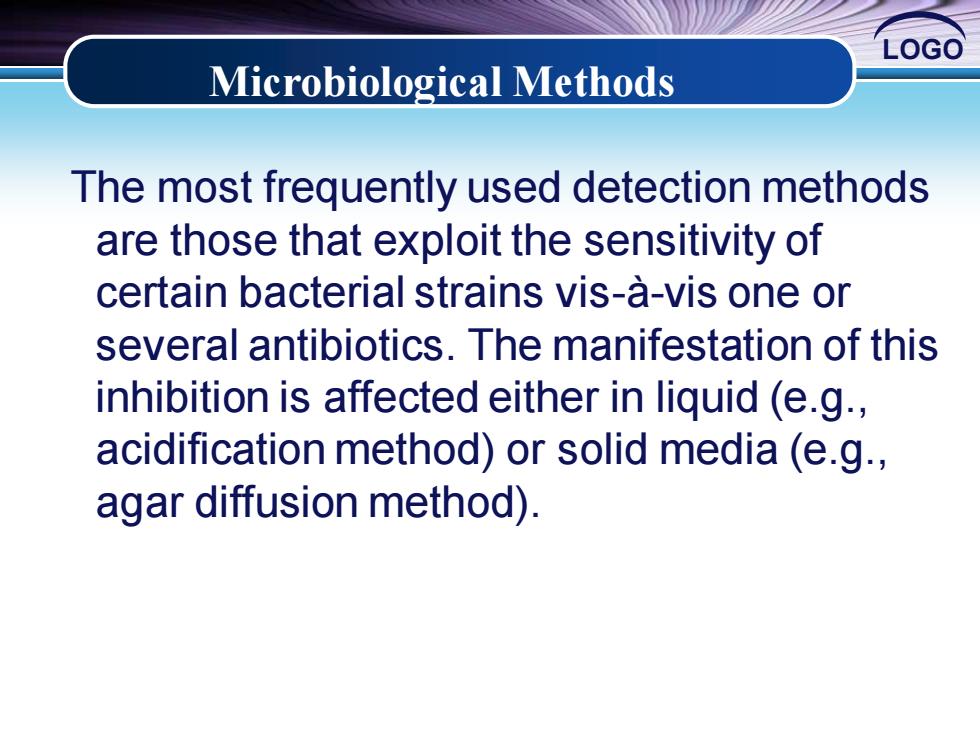
LOGO Microbiological Methods The most frequently used detection methods are those that exploit the sensitivity of certain bacterial strains vis-a-vis one or several antibiotics.The manifestation of this inhibition is affected either in liquid (e.g., acidification method)or solid media(e.g., agar diffusion method)
LOGO The most frequently used detection methods are those that exploit the sensitivity of certain bacterial strains vis-à-vis one or several antibiotics. The manifestation of this inhibition is affected either in liquid (e.g., acidification method) or solid media (e.g., agar diffusion method). Microbiological Methods
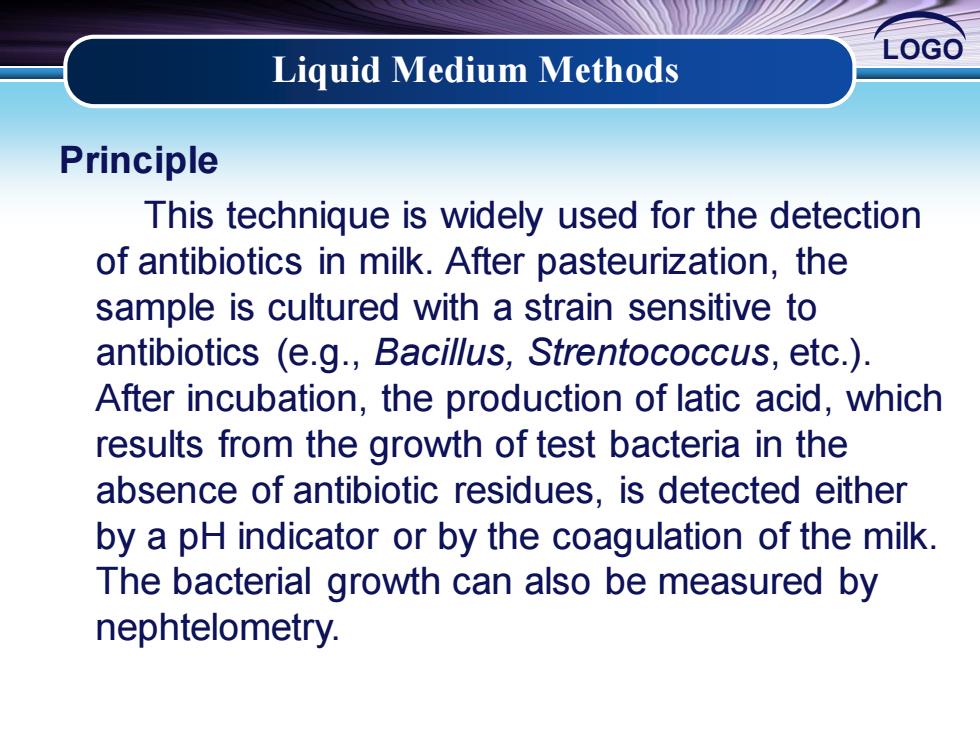
LOGO Liquid Medium Methods Principle This technique is widely used for the detection of antibiotics in milk.After pasteurization,the sample is cultured with a strain sensitive to antibiotics (e.g.,Bacillus,Strentococcus,etc.). After incubation,the production of latic acid,which results from the growth of test bacteria in the absence of antibiotic residues,is detected either by a pH indicator or by the coagulation of the milk. The bacterial growth can also be measured by nephtelometry
LOGO Principle This technique is widely used for the detection of antibiotics in milk. After pasteurization, the sample is cultured with a strain sensitive to antibiotics (e.g., Bacillus, Strentococcus, etc.). After incubation, the production of latic acid, which results from the growth of test bacteria in the absence of antibiotic residues, is detected either by a pH indicator or by the coagulation of the milk. The bacterial growth can also be measured by nephtelometry. Liquid Medium Methods
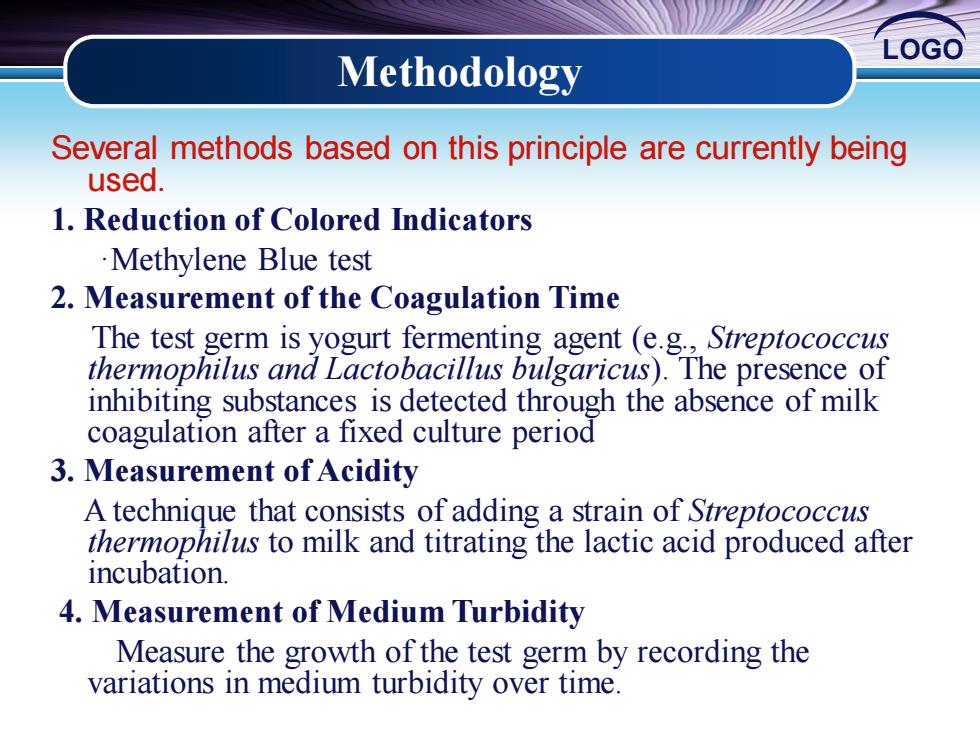
LOGO Methodology Several methods based on this principle are currently being used. 1.Reduction of Colored Indicators Methylene Blue test 2.Measurement of the Coagulation Time The test germ is yogurt fermenting agent (e.g.,Streptococcus thermophilus and Lactobacillus bulgaricus).The presence of inhibiting substances is detected through the absence of milk coagulation after a fixed culture period 3.Measurement of Acidity A technique that consists of adding a strain of Streptococcus thermophilus to milk and titrating the lactic acid produced after incubation. 4.Measurement of Medium Turbidity Measure the growth of the test germ by recording the variations in medium turbidity over time
LOGO Several methods based on this principle are currently being used. 1. Reduction of Colored Indicators ·Methylene Blue test 2. Measurement of the Coagulation Time The test germ is yogurt fermenting agent (e.g., Streptococcus thermophilus and Lactobacillus bulgaricus). The presence of inhibiting substances is detected through the absence of milk coagulation after a fixed culture period 3. Measurement of Acidity A technique that consists of adding a strain of Streptococcus thermophilus to milk and titrating the lactic acid produced after incubation. 4. Measurement of Medium Turbidity Measure the growth of the test germ by recording the variations in medium turbidity over time. Methodology
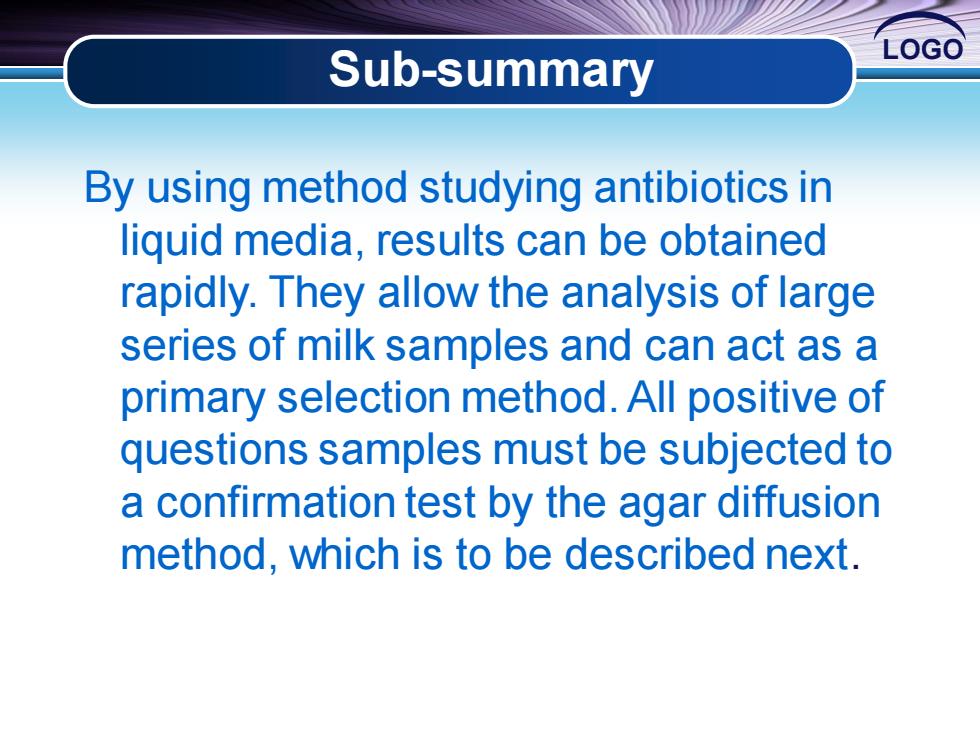
LOGO Sub-summary By using method studying antibiotics in liquid media,results can be obtained rapidly.They allow the analysis of large series of milk samples and can act as a primary selection method.All positive of questions samples must be subjected to a confirmation test by the agar diffusion method,which is to be described next
LOGO By using method studying antibiotics in liquid media, results can be obtained rapidly. They allow the analysis of large series of milk samples and can act as a primary selection method. All positive of questions samples must be subjected to a confirmation test by the agar diffusion method, which is to be described next. Sub-summary
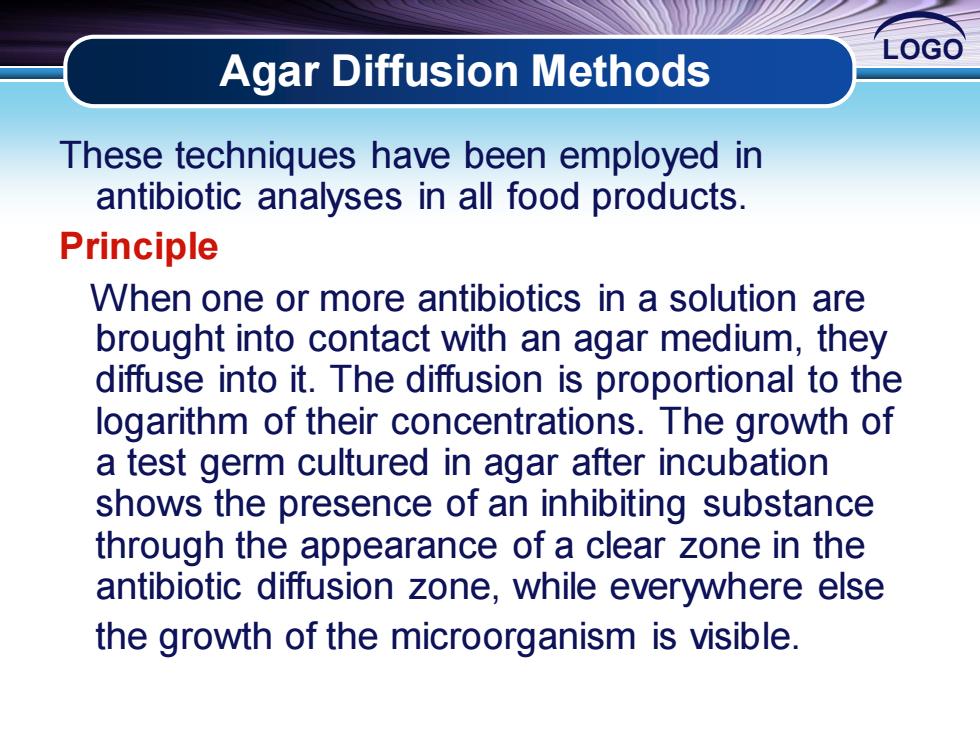
Agar Diffusion Methods LOGO These techniques have been employed in antibiotic analyses in all food products. Principle When one or more antibiotics in a solution are brought into contact with an agar medium,they diffuse into it.The diffusion is proportional to the logarithm of their concentrations.The growth of a test germ cultured in agar after incubation shows the presence of an inhibiting substance through the appearance of a clear zone in the antibiotic diffusion zone,while everywhere else the growth of the microorganism is visible
LOGO Agar Diffusion Methods These techniques have been employed in antibiotic analyses in all food products. Principle When one or more antibiotics in a solution are brought into contact with an agar medium, they diffuse into it. The diffusion is proportional to the logarithm of their concentrations. The growth of a test germ cultured in agar after incubation shows the presence of an inhibiting substance through the appearance of a clear zone in the antibiotic diffusion zone, while everywhere else the growth of the microorganism is visible
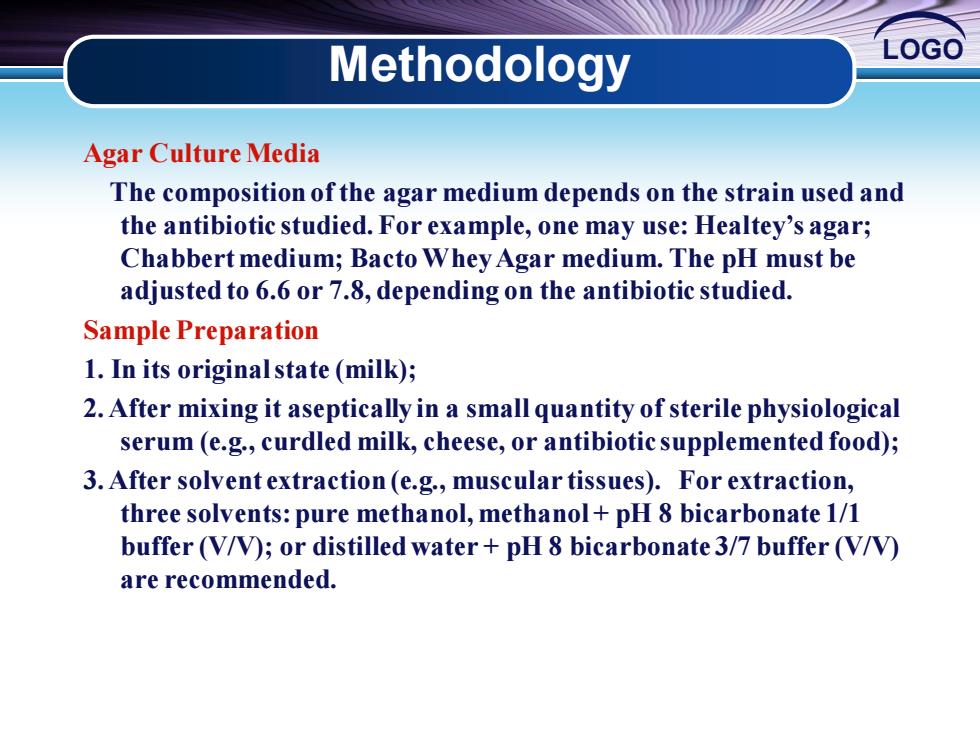
Methodology LOGO Agar Culture Media The composition of the agar medium depends on the strain used and the antibiotic studied.For example,one may use:Healtey's agar; Chabbert medium;Bacto Whey Agar medium.The pH must be adjusted to 6.6 or 7.8,depending on the antibiotic studied. Sample Preparation 1.In its original state(milk); 2.After mixing it aseptically in a small quantity of sterile physiological serum (e.g.,curdled milk,cheese,or antibiotic supplemented food); 3.After solvent extraction(e.g.,muscular tissues).For extraction, three solvents:pure methanol,methanol+pH 8 bicarbonate 1/1 buffer (V/V);or distilled water pH 8 bicarbonate 3/7 buffer (V/V) are recommended
LOGO Agar Culture Media The composition of the agar medium depends on the strain used and the antibiotic studied. For example, one may use: Healtey’s agar; Chabbert medium; Bacto Whey Agar medium. The pH must be adjusted to 6.6 or 7.8, depending on the antibiotic studied. Sample Preparation 1. In its original state (milk); 2. After mixing it aseptically in a small quantity of sterile physiological serum (e.g., curdled milk, cheese, or antibiotic supplemented food); 3. After solvent extraction (e.g., muscular tissues). For extraction, three solvents: pure methanol, methanol + pH 8 bicarbonate 1/1 buffer (V/V); or distilled water + pH 8 bicarbonate 3/7 buffer (V/V) are recommended. Methodology
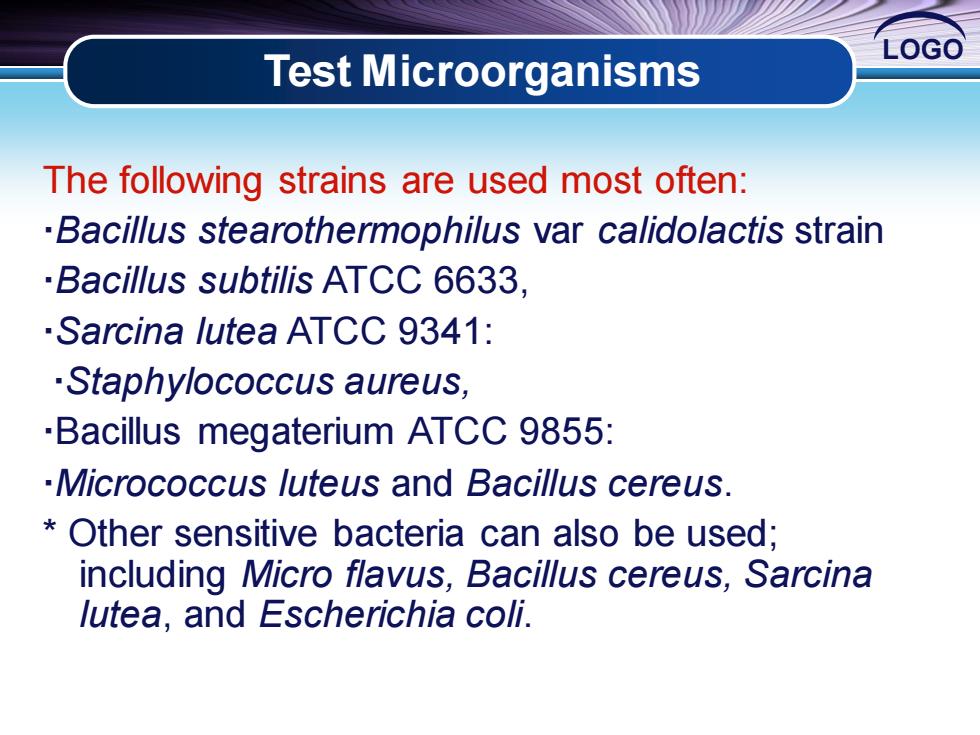
LOGO Test Microorganisms The following strains are used most often: .Bacillus stearothermophilus var calidolactis strain Bacillus subtilis ATCC 6633, .Sarcina lutea ATCC 9341: .Staphylococcus aureus, Bacillus megaterium ATCC 9855: .Micrococcus luteus and Bacillus cereus. Other sensitive bacteria can also be used; including Micro flavus,Bacillus cereus,Sarcina lutea,and Escherichia coli
LOGO The following strains are used most often: ·Bacillus stearothermophilus var calidolactis strain ·Bacillus subtilis ATCC 6633, ·Sarcina lutea ATCC 9341: ·Staphylococcus aureus, ·Bacillus megaterium ATCC 9855: ·Micrococcus luteus and Bacillus cereus. * Other sensitive bacteria can also be used; including Micro flavus, Bacillus cereus, Sarcina lutea, and Escherichia coli. Test Microorganisms